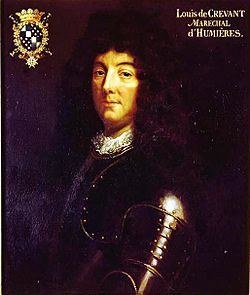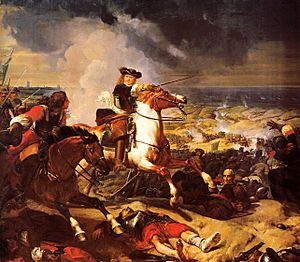Louis de Crevant, Duke of Humières facts for kids
Quick facts for kids
Louis de Crevant, Duke of Humières
|
|
|---|---|

Louis de Crevant, Duke of Humières
|
|
| Born | ca 1628 Château d'Azay-le-Ferron, Indre |
| Died | 30 August 1694 (aged 66) Versailles |
| Buried |
Church of Saint Martin, Monchy-Humières
|
| Allegiance | |
| Years of service | 1648-1690 |
| Rank | Marshal of France 1668 |
| Commands held | Grand Master of Artillery 1685-1694; Commander, Army of Flanders 1683-1684 and 1688-1689 |
| Battles/wars | Franco-Spanish War 1635-1659 Battle of the Dunes 1658 War of Devolution 1667-1668 Franco-Dutch War 1672-1678 Cassel 1677 War of the Reunions 1683-1684 Nine Years War 1688-1697 Walcourt 1689; Namur 1692 |
| Awards | Order of the Holy Spirit 1688 |
| Other work | Governor of French Flanders (1667-1674) Hainaut and Bourbonnais; Lille and Compiègne |
Louis de Crévant, who later became the Duke of Humières (1628–1694), was an important French nobleman in the 1600s. He rose through the ranks to become a Marshal of France in 1668. This was a very high military position. In 1685, he also became the Grand Master of Artillery, which meant he was in charge of all the cannons and big guns for the French army.
Many people believed his career got a boost because of his mother's family, the Phélypeaux family. They had many important jobs in the government of King Louis XIV. Louis de Crévant was put in charge of the French army in Flanders at the start of the Nine Years War (1688-1697). However, after a defeat at the Battle of Walcourt in 1689, he was removed from command. He was made a duke in April 1690 and passed away in 1694.
Contents
Early Life and Family
The de Crévant family came from a place called Azay-le-Ferron in France. Louis's grandfather gained the title and lands of Humières in 1595. This happened when he married Jacqueline d'Humières, who was the last person left in her family line.
Louis de Crévant (1628-1694) was one of nine children. His parents were Louis III de Crevant (born around 1606, died 1648) and Isabelle Phélypeaux (1611-1642). Back then, it was common for younger sons in noble families to stay unmarried. This helped keep the family's land and wealth together, instead of splitting it among many heirs.
Of Louis's brothers who grew up, two became high-ranking officers in the French Navy. Jacob died in Messina in 1675, and Raymond lived from about 1629 to 1688. Two other brothers, Roger (died 1687) and Balathasar (died 1684), joined a religious military group called the Knights of Malta. His sisters, Marie and Isabeau, became nuns.
In March 1653, Louis de Crévant married Louise Antoinette de la Châtre (1639-1723). She later became a Lady-in-waiting to Queen Maria Theresa. They had four daughters and two sons. Their son Henri-Louis was killed during the Siege of Luxembourg in 1684. Their other son, Louis-François-Roger, died in 1679. Their daughters were Marie-Thérèse (born around 1652, died 1687), Marie-Louise (1658-1710), Anne-Louise (born around 1666, died 1717), and Anne-Louise-Julie (1665-1748).
Military Career
In the early 1600s, France faced many problems both inside and outside the country. France mostly stayed out of the Thirty Years' War (1618-1648). However, supporting the Dutch Republic in its fight for independence from Spain led to the Franco-Spanish War (1635-1659). At home, religious conflicts, known as the French Wars of Religion, started again in the 1620s.
When Louis XIV became king in 1643 at only five years old, there was a struggle for power. This led to a civil war from 1648 to 1653, called the Fronde. During this time, Humières supported the king's side. He took part in the later parts of the Franco-Spanish War. By 1658, he had become a Lieutenant-General, a high military rank. He fought in the Battle of the Dunes under a famous general named Turenne. This was a big victory for France and led to the Treaty of the Pyrenees in 1659.
War of Devolution and New Challenges
In the War of Devolution (1667-1668), France quickly took over parts of the Spanish Netherlands. Humières helped in the Siege of Lille in 1667. In 1668, he was promoted to Marshal of France.
However, the Dutch Republic preferred to have a weaker Spain as a neighbor, not a strong France. So, the Dutch, along with England and Sweden, formed the Triple Alliance. This forced King Louis XIV to give back most of the land he had gained in the Treaty of Aix-la-Chapelle in 1668. Louis was upset, feeling the Dutch were ungrateful. He then started planning to invade the Netherlands.
In April 1672, Turenne was made the senior commander of French forces in the Netherlands. This caused a problem because Marshals usually did not serve under other Marshals. Humières, de Créquy, and Bellefonds refused to serve under Turenne. They felt it would hurt their reputation and the importance of being a Marshal. Because of this, all three were sent away to their family estates.
Franco-Dutch War and Later Campaigns
The Franco-Dutch War began in May 1672. At first, the French army quickly took over much of the Dutch Republic. It looked like a complete victory. But by late July, the Dutch managed to stabilize their position. They gained support from Brandenburg-Prussia, Emperor Leopold, and Charles II of Spain. As new battlefronts opened, French troops left the Dutch Republic by the end of 1673. They only kept two towns, Grave and Maastricht.
By 1673, Humières and the other two Marshals had apologized and were allowed back into service. Humières spent most of the war fighting in the Spanish Netherlands, mainly involved in sieges (surrounding and attacking towns). In the War of the Reunions (1683-1684), he led the French army in Flanders. He captured the Spanish towns of Kortrijk and Diksmuide in November 1683.
During the Siege of Luxembourg, which ended in June 1684, Humières' son and heir, Henri-Louis, was killed. After the siege, France agreed to return some conquered lands in exchange for keeping Luxembourg and Strasbourg. This agreement was called the Truce of Ratisbon.
Nine Years' War and Final Years
The Truce of Ratisbon was supposed to last 20 years, but it ended in 1688. King Louis XIV started the Nine Years War by invading the Dutch Republic. Humières had been made Grand Master of Artillery in 1685. He was again given command of the Army of Flanders. However, he was defeated by the forces of the Grand Alliance at the Battle of Walcourt in August 1689.
After this defeat, he was replaced by the Duke of Luxembourg. Humières was present at the Siege of Namur in 1692, but this marked the end of his military career. He was made Duc d'Humières in April 1690. In May, his daughter Anne-Louise-Julie (1665-1748) married Louis François d'Aumont. Their marriage contract stated that he would inherit the Duke title.
Legacy and Burial
Louis de Crévant spent his final years at the Chateau de Monchy-Humières. He made many changes to the castle and added large, beautiful gardens. The gardens are gone now, but the castle still stands. He was buried in the local church of Saint Martin. Many tombs in the church were destroyed during the French Revolution. In 1936, a marble statue from the chateau was sold. It was thought to be from Louis's tomb, but it was actually a statue of Jean III d'Humières (who died in 1553). This statue, made by the sculptor Jean Bontemps, is now in the Louvre museum.
| French nobility | ||
|---|---|---|
| Preceded by Louis III de Crevant |
Marquis d'Humières 1648–1690 |
Succeeded by elevated to duke |
| Preceded by first creation |
Duke of Humières 1690–1694 |
Succeeded by Louis François d'Aumont |
| Military offices
|
||
| Preceded by Henry de Daillon |
Grand Master of Artillery 1685–1694 |
Succeeded by Louis Auguste, duc de Maine |
| Preceded by Louis III de Crevant, Marquis d'Humières |
Governor of Compiègne 1646–1694 |
Succeeded by Louis François d'Aumont, 2nd duc d'Humières |
See also
 In Spanish: Louis de Crevant para niños
In Spanish: Louis de Crevant para niños





